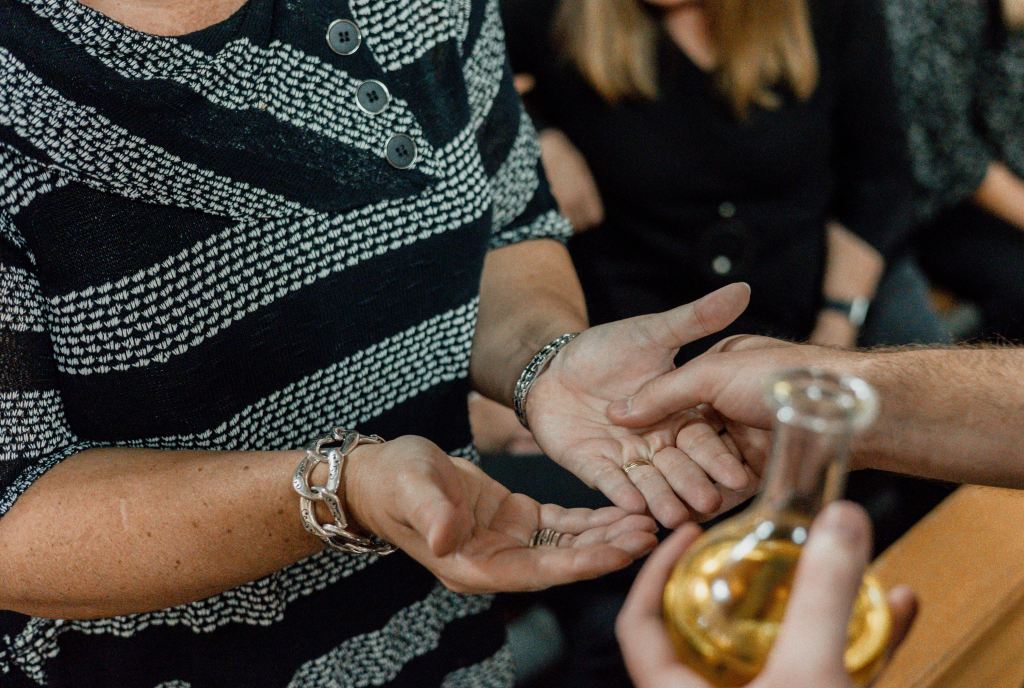
This Sunday, one of my churches will be having a healing service as part of our Sunday liturgy. This has become our practice for the third Sunday of the month, and it has become a meaningful practice.
Growing up, “healing services” were things that charismatics did when they pushed people over and other strange things and then people who were in wheelchairs were supposed to walk, or cancer suddenly disappears, or the blind being able to see. Growing up Dutch Reformed, we didn’t have anointing of the sick as a sacrament, and as a historic Protestant, the above-mentioned faith healers were, at best, newfangled and, at worst, charlatans. This doesn’t mean that we didn’t think that God had a role in the wholeness of the human person. We prayed fervently for people who were sick, understanding that this wasn’t some kind of magic incantation which would make things happen.
A small town boy arrives in the Inner City
It was a bit of a shift when I arrived at my first church and learned that it was their custom to have a healing service as part of the Sunday Liturgy once a month. My first church was in the inner-city, and our congregation was made up of people who were unhoused, people who had significant and persistent mental illness, people who were barely housed, people who were barely holding things together. Not only this, but several of our members were immigrants and had rather harrowing stories about how they got here. In my congregation and community there was so much felt brokenness in so many ways, and in contrast to the small midwestern community where I grew up, brokenness wasn’t a secret. And the healing service was immensely meaningful to so many people. And we didn’t have a single blind eye gain sight, no cancer went away, and no mental illnesses suddenly evaporated. And. yet, the meaning indicates that people were experiencing healing.
Healing vs Curing
One of the things that I think is helpful to keep in mind, is that curing and healing are two distinct things. Healing can come without curing, and curing can happen without healing.
In my pastorate, I have sat with many people while they were in the process of dying. And different people respond to the reality of dying in very different ways. Some will grasp for every possible curative possibility, regardless of how remote the chances for success, and end up dying in the process of grasping for anything that will prolong life. and others, will find a sense of peace in the process and the reality of the inevitable. It’s not resignation or fatalism, but there’s a positive sense of peace with one’s life and its conclusion. This doesn’t mean that they’re happy to die, not at all, but we can find a peace with things we do not prefer.
Both kinds of people die, but I am convinced, that the latter experience healing, even though they were not cured.
Cure is objective, healing is subjective. Cure is a binary, healing is a process.
Cure is physical, healing is spiritual.
And this is the experience that I saw with my parishioners in the first church. Being anointed with oil, having the elders put their hands on the person’s shoulders, and having the pastor give a blessing was deeply meaningful and deeply effective even though no one experienced a miraculous cure.
Could it happen? Of course! But this wasn’t our expectation and our understanding of efficacy was not dependent on this.
Who needs healing? What does healing look like?
Our healing services are pastoral care for the congregation. Whenever another elder is there, at least one elder will be with me so that it’s not about me, but the church. I have no special gift here. There’s no falling, no special effects, no theatrics. I’m not a “healer” in that I don’t claim to have the ability to eradicate illnesses or pain or any form of disability. Nor do I expect anything like this to happen. That’s not what we are about.
Rather, this is a ministry of the church (which is why elders also participate in this) that helps to encourage healing rather than curing. So who needs healing? The invitation I give is broad: those who experience brokenness in body, mind, spirit, or relationship. The invitation is to self-identify. Someone with a disability is not necessarily experience brokenness. Someone who is in peak physical condition may be experiencing brokenness. There’s not expectation that any type of person will or will not come forward.
And what does healing look like? I don’t even begin to define this. What healing can look like can be as diverse as the people who are in the service. For someone with a newly obtained disability, for instance, the loss of hearing in old age, healing may not look like the regaining of hearing, but rather the ability to accept their body as it currently is rather than being continually bitter about it. For someone who had a rupture in a relationship, healing may not look like getting back together, but the ability to bless that chapter in their life and turn to another one in an unexpected way. These are no less real, and are no less the work of Divine action.
Why I think this is valuable
So if we don’t expect sudden and miraculous cures, then what is the purpose? Is it just wishful thinking?
While in my tradition, this is not a sacrament, I think it could rightly be called sacramental.
So much of what the church does is a visible and tangible sign of a spiritual reality. If healing is, as I contend, primarily spiritual, then this is something that could open someone to this spiritual reality. It is a rite that points beyond ourselves, it is something which brings us together with God, and allows us to offer whatever is broken in our lives and ask God to mend it. As sacramental, we might also say that God does something special in that moment. The ritual is also multi-sensory. It is not simply something of the mind, but it responds to the embodied reality of the human condition. We are made as embodied people, and the ministry of the church is not just some intangible reality, but also reflects this embodiment. As such, we seek to be concerned about the bodies of humans, but also we seek to engage with the senses of the bodies of humans. The oil is infused with frankincense and myrrh, I lay my hand on their head, and I speak a blessing.
There is no doubt in my mind that there is something ineffable that happens in that moment, and that ineffable thing might lead to healing.


Join in and share your thoughts!